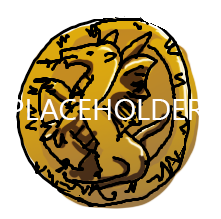History
Most early currencies and coins were valued primarily by their weight and purity rather than their face value. Heavy bullion coins were frequently traded between merchants, and change was made by cutting the coin up much like slices of a pie. An eighth was known as a piece or a bit, with a fourth or half known as two-piece or four-piece respectively.
The First Mint
The
Gilded Hoard, then known as the Medivetti Bank, began melting down bullions and minting smaller coins in
648 WE to meet this demand for lower dominational currency. The first to be minted was the Silver Sun, which had the same value as a piece, and copper dimes, which were worth a tenth of the suns. It was quickly adopted. The rounded coins were far nicer to use than the sharply-edged pieces.
Despite, or
perhaps because of, it's great success and massive profits, after only six years the Medivetti bank stopped minting. The Medivetti Bank stopped producing coins from 654 WE until 664 WE, focusing on their standard financial services.
Denouncement
In 664 WE the Medivetti Bank announced that they would start minting again, and that they'd developed enchantments that protect their coins from debasement. They were lambasted by the guilds and ridiculed. Economists of the time denounced the bank, claiming such enchantments, while possible, were far too expensive to be preformed on coinage. It was impossible that the coins that would enter circulation would have the same enchantments as the coins the Medivetti used in their demonstrations. The Medivettis became, for a time, synomous with charlatans.
They persisted with the mint. The coinage saw little use until an economist with a personal grudge against the Medivetti family saw fit to prove what everyone knew, and show that the family were undeniably charlatans. The economist collected as many of the new coins as he could, and gathered the Guilds of Metallurgy to view as he shaved the standard coins. His dagger chipped on the first one. The only Medivetti Silver Sun he could easily debase was a coin from their earlier mint, marked 649 WE. The Medivettis couldn't have paid for better marketing.
It still took a while before the coinage saw widespread adoption.
The Reveal
As soon as the Medivettis claims that the coins were resistant to debasement was proven true, the other banks launched into investigations on how exactly the Medivetti family was able to enchant their coins. It was a sorcerer of the draconic tradition who first clued in to the nature of the coins, and who
courteously sent a letter to the Medivetti family about their discovery.
In 698 WE the Medivetti announced that they were rebranding to the
Gilded Hoard. They revealed their collaboration with the dragon Esereum and introduced a new coin to their collection in their honor, the Gold Drake. The drake was made their new standard, and the Copper Dime bacame the Copper Cent.
















Oh DANG I love how much thought you've put into your monetary system! And the magical protection against the coinage losing value is such a cool concept. Hilarious that in trying to prove them liars--and failing--that economist accidentally elevated the people he hated -- ah, I do so love it when tables turn on the petty. XD
You are doing a great job! Keep creating; I believe in you!
Luridity: Where love is love and life is lived. Contains NSFW content.
Now with serialized fiction on Ream!!
Thank you so much! It all worked together so well, it's been really fun to find reasons why a single currency is so widely adopted and so stable, and it's lead to a spin I'm fond for my dragons. I'm so excited to write more!